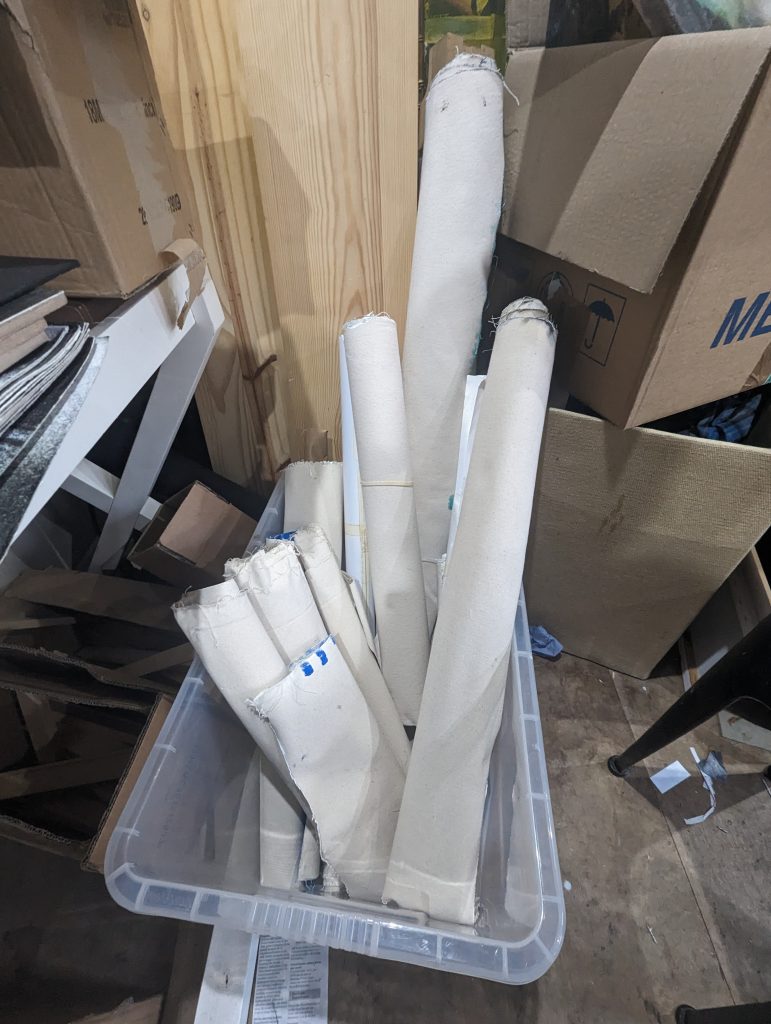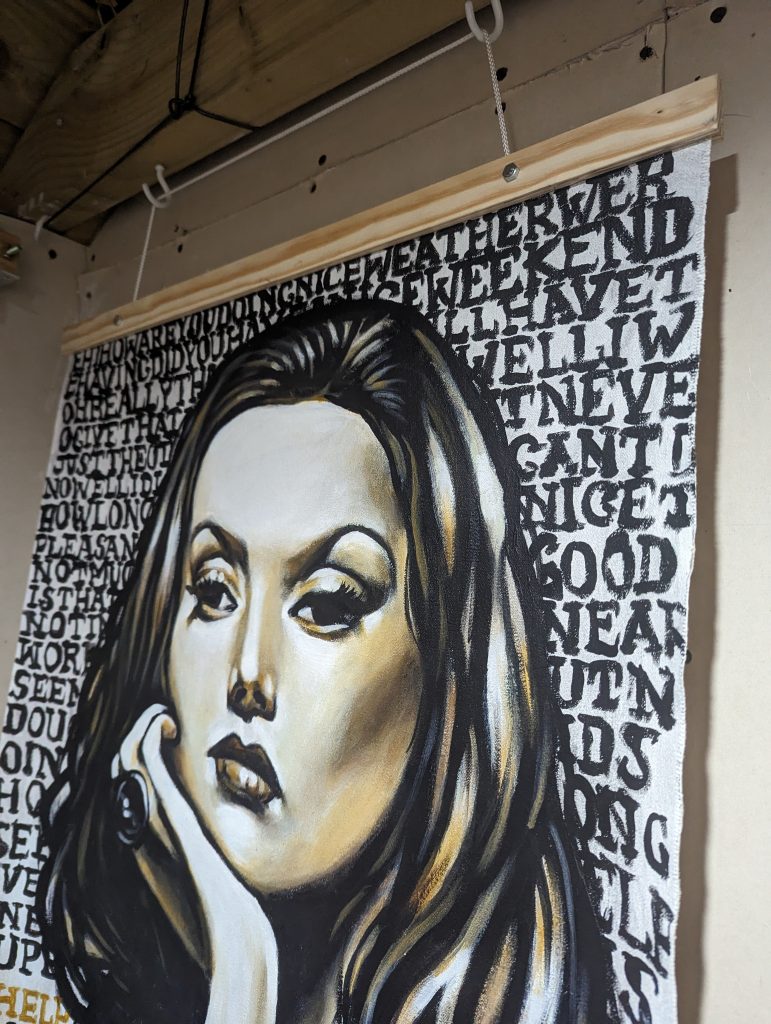Your basket is currently empty!
Here’s what my studio looks like today:

It’s always a bit of a mess, and since I’m ramping up for an exhibition, it’s particularly chaotic. You’ll note my “washing line” along the back wall. This is actually a washing line chord, but I don’t tend to use it for drying paintings, or clothes for that matter. It’s where I put my works-in-progress or works-on-hold or works-that-might-be-finished-but-I’m-not-sure-yet-so-keep-them-somewhere-visible-to-marinade-on-them-for-a-while.
Also on the line currently are some larger pieces with which I’m experimenting to test a new way of mounting my works – as posters on hangers. This came about as a byproduct of how I create my work, as well as a bit of dumbassery. Let me explain.
I like to paint on canvas, and tend to like painting quite large works. Up until a couple of years back, I assumed this meant that I needed to buy pre-made canvases, already on stretchers, and just get whatever was in my brain down on those. This didn’t really work for me for a variety of reasons:
- I don’t really plan my work. My ADHD brain gets bored if I work on the same concept for too long, so by the time I get to the point of putting stuff on a canvas my enthusiasm has likely pointed itself at some other shiny thing. So I tend to just get stuck in. This, predictably, leads to a lot of misfires. I’m fine with this, it’s what you might call an occupational hazard. I tend to let these little failed experiments lurk for a bit, before either painting them out and reusing the canvas, or taking them in a new directions. So far so awesome. Except it means that I’ve always got loads of half-finished artworks sitting in corners gathering dust which is a) an expensive way to work and b) leads to the next problem:
- I churn out quite a lot of work, and when you combine works-in-progress, finished works, and primordial soup mentioned in point 1, it amounts to quite a lot of fairly large artworks on stretched canvases. Apart from those that I can find space for on my walls, the rest sit in piles in whatever space I can find, where they seem to mysteriously multiply.
- As much as I see the value of creating works in uniform dimensions, the reality is that I’m not very good at it, and finding stretched canvases to suit my whims at any point is problematic and often expensive. Related to this point and said expense:
- When I get an idea in my head I like to work really quickly and can get seriously twitchy if I don’t have the basic things I need around me RIGHT FECKING NOW!!! Refer to points 2 and 3 for why this is problematic

In my last house I had no studio and relatively little spare “piles of stuff” space, so I needed to find a solution. It occurred to me that it’s actually the stretchers that take up the bulk of the space. Since I usually work in acrylics, a medium that is both flexible, fast-drying and durable, I could in theory just pile them or roll them up if it wasn’t for all this pesky wood. Then, if I wanted to display them or whatever, I could just stretch them, on-demand as it were. So I set about figuring where to buy stretchers, canvas and primer separately (and all the other tools and bits) and figuring out how all this would work. And so I have my solution: I cut out bits of canvas, staple them to bits of wood where I prime them, make may creative juices flow all over them, then unstaple them once they’re dry and deposit them in much more manageable piles in the aforementioned corners. Woo hoo!

Any way, back to my original thread: the whys and wherefores of canvas paintings on hangers. You see, if you want to work this way, you need to prepare your painting in such a way as to make it suitable for stretching. What this means is that you need to compose your picture in such a way as to leave the bits of it that you want to be visible, visible once you stretch it, and not round the back, callously pierced with staples. The trick is to not paint up to the edge of the canvas. Simple enough you might think, simply mark out the visible portion based on the dimensions of the stretcher you intend to use, and keep the bits of the image you intend to be facing the viewer within these. Well this assumes that you are not the owner of a swiss-cheese, impulsive and slightly vindictive avian-brain! I always start out with good intentions, but often only remember that I needed to think through the stretching problem after having lovingly crafted an artworks for days or weeks, at which point there’s no turning back! This has happened quite a few times, although I will defend myself by pointing out that this is a error that I have not made in quite a while!
But what to do with the gorgeous artworks that received this bird-brained treatment? I can’t stretch them. At best they’ll look odd, at worst they’ll be ruined. So they’ve been hanging around on my washing line, or rolled up in piles for months or even years, until now, when I cooked up a solution to the problem: don’t stretch them, transform them into tasteful and practical posters! This involves cutting thin wooden strips to size and bolting them to the top and bottom of the paintings (I’ve only done the bottoms so far). I think it looks pretty neat, stylish even, and it makes them a bit more practical since they can be rolled up like any normal poster and stored away (presumably because you’ve invested in another one of my artworks and you don’t have space for both!).
The moral of the story? Adversity breed creativity. Also, creativity breeds adversity. But what breed birds? We’ll never know.

